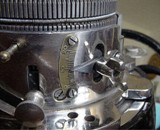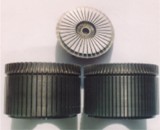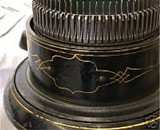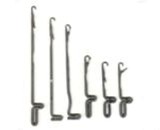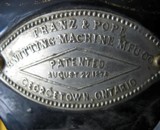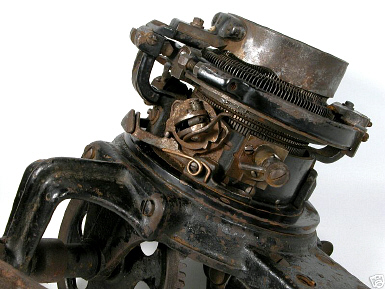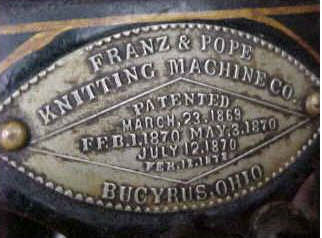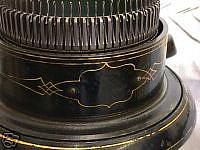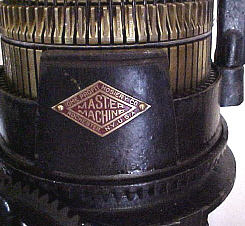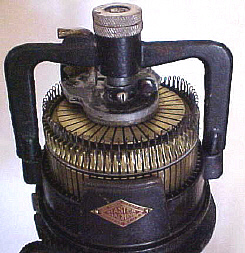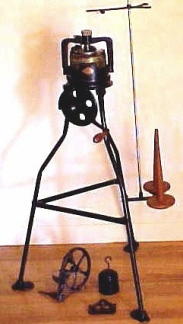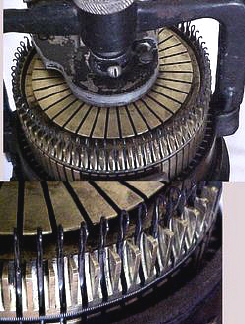|
Oldtymestockings American
Sock Machine Museum
|
|
|
|
Ainslie Auto Knitter Knitting Machine
The Ainslie Auto Knitter Sock
Machine was manufactured in Brooklyn, New York by the
Ainslie Knitting Machine Company. Located on Ainslie
Street, the firm's name was synonymous with its location.
Ainslie Auto Knitters were produced during the era of the Canadian Auto Knitters. Hence, differences are
subtle.
Ainslie Auto Knitters were known
for their cherry red handles and deeply notched bed plates.
Unlike standard Auto Knitters whose bed plates were mirror
images, the Ainslie bed plates were asymmetrical and deeply
notched on the right edge. These characteristics distinguish the Ainslie Auto Knitters from the Canadian, Fricke
and Bogan Auto Knitters.
The Ainslie patent label was
fastened to the side of the cam shell with two screws,
usually on top of the original Auto Knitter decal. The
patent label featured gold lettering and trim on a black or
burgundy background. The company's name, address and
serial number of the machine were clearly displayed.
Ainslie Auto Knitters were available in a wide variety of
ribber dial and cylinder combinations. 30/60, 36/72 and
40/80 outfits were quite common. |
|
|
|
American Family
Knitting Machine
Distributed between 1868
and 1873 as the American Family Knitting Machine, this sock
machine was based on Dana Bickford's original patents. The
manufacturing firm, Johnson Clark & Co. of Boston,
Massachusetts & St. Louis, Missouri, ceased trading in
1873. Subsequently, their sock machine patterns and rights
were sold to J. E. Ford & Co.,of Montreal, Canada.
This unique circular sock
machine is quite charming and rare in design. The golden
etchings and green foliage impart a warm appeal.
Unlike traditional sock machines, i.e. Gearharts, Auto
Knitters, Legares, American Family Knitting Machines did not
utilise cams to lift or lower the needles. In fact, the
needle path is engraved inside the cam shell. In addition,
the gear ring is constructed within the 72 slot cylinder.
This sock machine has an
unusual design. Ribbing attachments, yarn rods, yarn
masts and yarn carriers were omitted. Yarn was knitted
directly from bobbins which were seated in the back of the
machine. Heel tension was obtained by threading yarn
into one or both eyelet holes of the wire yarn guide.
Tension for the cylinder was acquired by manipulating the
black screw at the front of the sock machine. This would
lower or raise the needles as they flowed through the needle
path. |
|
| Auto Knitter Knitting
Machine The
American Auto Knitter sock machine was manufactured at the
height of the depression between the years 1920 and 1940.
This was a time when approximately 600 banks failed each
year; "technological unemployment" entered the nation's
vocabulary; agricultural, energy and coal mining sectors
were continually depressed; construction of textiles, shoes,
shipbuilding and railroads fell $2 billion; more than half
of all Americans were living below a minimum
subsistence level; and investors termed the 29th of October,
1929 as "Black Tuesday". Losses for the month of
October totaled $16 billion, an exorbitant
sum in those days.
With the high cost of steel
and limited industry, the Auto Knitter company constructed
parts of their circular knitting machines from zinc alloys,
commonly known as pot metal. This manoeuvre increased
the survival of the company during one of the most difficult
economic periods of the century. Even so, the Auto
Knitter company, like many commercial enterprises, endured
continued financial strain and eventually went to the
receivers.
The Auto Knitter circular
knitting machine was available in a wide variety of ribber
dial and cylinder combinations. 30/60,
36/72, 40/80, and 50/100 outfits were readily available. Additional combinations could be
acquired on special order. |
|
|
Bickford Family Knitting Machine
First patented
the 10th of September, 1867, Bickford Family Knitting
machines were produced by the Bickford Knitting Machine
Manufacturing Company of Brattleboro, Vermont.
Bickford Family Knitting machines were prodigiously
decorated with gold scrolling on their bed plates, cam
shells and crank handles.
Bickford Family
Knitting machines were intended to meet all of the
domestic needs of the household. The company routinely
advertised that
Bickford Family knitting machines could readily produce
ottoman covers, looped trimmings, carriage and door mats,
hoods, breakfast shawls, blankets, nubias, table and piano
covers, slippers, sashes, capes, tuftings, lamp mats and a
host of other articles.
Bickford
knitting machines were manufactured without ribbing attachments and came
standard with 72 and 100 slot cylinders.
|
|
|
Bogan Harmony Auto Knitter
Known for its emerald green
hue and red stripes, the Bogan Harmony Auto Knitter was
manufactured by the Bogan family from 1984 until the
early 1990s. Like the Fricke Harmony Auto
Knitters, various models underwent modifications and
improvements.
A 30/60 combination, Harmony
Auto Knitter manual and a full array of
knitting accessories accompanied each machine. An
instructional video featuring Norma Bogan was also
available. Norma's classic, elementary style of
teaching continues to assist sock knitters worldwide.
|
|
| Branson Industrial
Knitting Machine
The Branson Industrial sock
machine was first patented on the 6th of May, 1979. A
final patent was attained on the 1st of May 1994.
During this time, the Branson Industrial sock machine
underwent various updates. However, the basic design
of the traditional sock machine and its customary crank
wheel were preserved. With high slot counts and
smaller gauge needles, the Branson Industrial knitting
machine was well-suited for fine, delicate hosiery and
trouser socks. |
|
| Cooperative Circular
Knitting Machine
The Cooperative sock machine was
manufactured in Indianapolis, Indiana. Quite elementary
in design, the Cooperative sock machine was not constructed
with a ribbing attachment. The Cooperative sock machine came standard
with a 72 slot cylinder and customary knitting accessories.
|
|
|
Franz and Pope Automatic Knitting Machine
The Franz and
Pope sock knitting machine was introduced in 1869 as a
family knitting machine for domestic use. Although
its premier purpose was to produce substantial hosiery, it
was also utilised to make fancy apparel, household
adornments and various items of practical use. The Franz
and Pope circular knitting machine came complete with a 72
slot cylinder, a 100 slot cylinder and a standard
array of knitting accessories.
|
|
|
Franz and Pope Nº2 Automatic Knitting Machine
The Franz and
Pope Nº2 sock knitting machine was one of the earliest
circular knitting machines manufactured by the Franz and
Pope knitting machine company. Unlike later models,
the Franz and Pope Nº2 knitting machine lacked lavish decor
and the
conspicuous silver patent label on the crank wheel. The Franz and Pope Nº2 sock
knitting machine was designed to knit work hosiery
from medium and heavy weight yarns. Work hosiery was stronger and
coarser than standard socks and worn chiefly by farmers
and sportsmen. The Franz and Pope Nº2.
circular knitting machine came complete with a 60 slot
cylinder and a standard array of knitting accessories.
|
|
| Franz
and Pope Nº4 Automatic Knitting Machine
The Franz and
Pope Nº4 circular knitting machine was notable for its
lavish embellishments and ornate decor. Golden decals
of birds and foliage encircle the cam shell, base plate and
crank wheel. The Franz and Pope Nº4 circular knitting
machine came complete with a 72 slot cylinder, a 100 slot
cylinder and a standard array of knitting accessories.
|
|
|
Fricke Harmony Auto Knitter 1982
Fricke Harmony Auto Knitters
were manufactured by
Harmony Knitters, Inc.
of Harmony, Maine. Through the joint efforts of
George Fricke,
Ralph McCarthy
and Kerry Bogan,
Harmony
Knitters, Inc. produced American Auto Knitters from the
early 1980s until mid 1984. Thereafter, the company
was sold
to the Bogans.
The bed plates of the Fricke
Harmony Auto Knitters were distinct from their Canadian
forerunners. In particular, the Auto Knitter logo was
not cast into the bed plates. In
addition, a holder for the ribbing attachment was absent.
Despite these differences, the traditional design of the
Canadian Auto Knitter was well-preserved.
The ribber dial of the 1982
Fricke Harmony Auto Knitter featured a wide "cut out" area
at the end of the needle slots. Later models
demonstrated a variation of this design. |
|
|
Fricke Harmony Auto Knitter 1984
Fricke Harmony Auto Knitters
were manufactured by
Harmony Knitters, Inc.
of Harmony, Maine. Stock parts for the machines were
purchased in the 1970s from a French Canadian brother and
sister partnership. Advancing age and infirmity
persuaded the sister partner to leave the business and sell
her share of Canadian Auto Knitter parts to George Fricke.
Castings and cylinders for the
Fricke Harmony Auto Knitters were redesigned. New
parts were constructed from
cast aluminum and machined by
Kerry Bogan. The ribber dials of the 1984 Fricke
Harmony Auto Knitters were modified. Note the slender
slots and tapered contour.
Fricke Harmony Auto Knitters
came standard with a 30/60 ribber dial and cylinder
combination. However, additional outfits such as 36/72
and 40/80 were readily available. |
|
|
Gearhart
Family Knitting Machine
With origins in
Clearfield, Pennsylvania, this America sock machine remains
a true favourite. During its age of manufacture, Gearhart
outfits varied considerably. Ribber dials ranged
from 16 to 70+ slots and cylinders ranged from 48 to 140+ slots.
Needle sizes varied as well. Many of Gearhart's sock
machines were manufactured without ribber attachments to
facilitate use. Wrought iron stands with needle and bobbin
holders were an added attraction. |
|
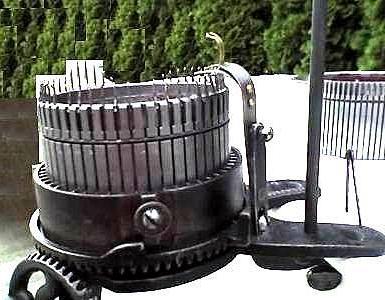 |
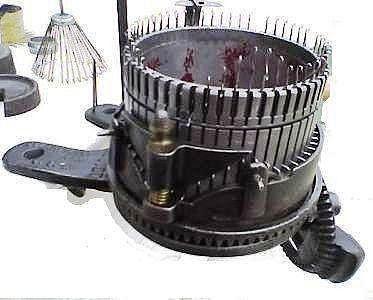 |
|
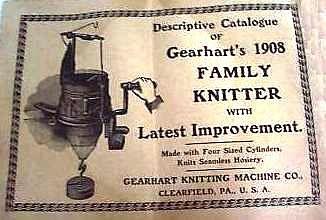 |
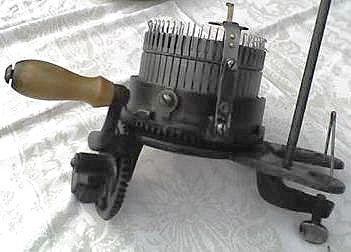 |
|
Gearhart's
1908
Family Knitter
The 1908
Gearhart Family Knitter is one of Gearhart's earliest
knitting machines. Improvements included a wider range
of cylinder outfits, the creation of a curved handle and a
newly designed yarn carrier. Cylinder counts of 52, 54
and 56 enabled the production of infant hosiery and sport
socks. In contrast to the long, straight crank handle
of previous models, Gearhart's 1908 Family Knitter
demonstrated a compact handle.
Cast iron,
flat-faced yarn carriers were the latest improvement.
Previous yarn carriers were manufactured from steel and
consisted of two or more parts. These parts were then
fastened or welded together to create the yarn carrier. Note the
differences between the photographed and catalog depicted
yarn carrier.
The ribbing
attachment remained elementary, for it lacked a lever to
disengage the ribbing attachment and a method to adjust ribber
tension.
Notwithstanding, its simple design and operation
makes the
1908 Gearhart Family Knitter a priceless treasure to many. |
|
|
Home Profit 3¾ Circular Knitting
Machine The
Home Profit 3¾ sock machine was a special edition knitting
machine. Marketed to knit infant and children's socks,
the Home Profit 3¾ sock machine came standard with a 36/72
combination. Note the comparison of the cam shell and
cylinder to Home Profit's standard 4½ sock machine. |
|
| Home Profit 400
Circular Knitting Machine
The Home Profit 400 sock
machines closely resemble the Creelman Brothers' 400 series
sock machines. The shape of the base, cam shell,
cylinder, ribber dial, crank wheel and tappet plate were
virtually identical to Creelman's patents. As one of
the largest manufacturing companies of their time, the
Creelman Brothers' produced numerous machines for private
companies. The P.T. Legare and the Home Profit
Knitting Machine companies were two of note. |
|
|
Home
Profit Knitter The Master Machine
Manufactured by
the Home Profit Hosiery Company until the late 1920s, this
American sock machine hails from Rochester, New
York. Beauty and brass were combined in this spectacular
sock machine. Features included a built in stand; unique,
two prong ribber attachment; solid brass ribber dials
and solid brass cylinders.
A 36 slot
ribber dial and 72 slot cylinder came standard with the Home
Profit knitting machine. However, 48 slot ribber dials
and 96 slot cylinders were also available. Special
edition Home Profit Master machines with 3¾" cylinder
diameters were produced to knit baby socks and children's
hosiery.
Home Profit
knitting machines were advertised by the Home Profit
corporation as "The Master Machine of All Knitters".
This American sock machine remains a gem amongst
collectors.
|
|
|
|
People 's High Speed Knitting Machine
The People's High Speed knitting
machine was manufactured in the early 1890s by Joseph. E. Gearhart in Clearfield, Pennsylvania. The People's High Speed
sock knitting machines were noteworthy for their revolving
needle cylinders. Despite numerous improvements, the
People's High Speed circular knitting machines retained a
remarkable similarity to the modern Gearhart family knitting
machines. |
|
|
Steber Family Knitting Machine
In 1906, Bernard
T. Steber created the Steber Machine Company which remained
in existence in Utica, New
York until 1936. Steber knitting
machines were advertised to homemakers as the ideal sock
machine to produce socks for the war effort. Steber sock
machines came standard with 24 slot ribber dials and 72 slot
cylinders. Additional cylinders of 52, 56, 64, 88, 100,
112, 120 and 140 slots were available at additional cost.
The Steber Machine Company invested a substantial amount of
time in advertising the quality of their machines and
declared that their cylinders were, "...made of a fine grade
of iron, the same as automobile cylinders, and should last a
lifetime." |
|
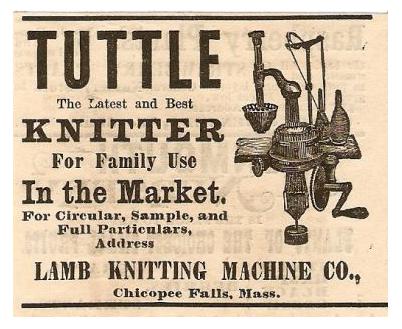 |
|
Tuttle Nº1 4½ Circular Knitting Machine
Elegance and
ingenuity are the hallmarks of this exceptional knitting
machine. Its soft contours, golden embellishments and
floral decor would persuade any woman to consider its use.
Patented in 1879
by the Lamb Knitting Machine Company as the first circular
knitting machine with a ribbing attachment, the lady of the
house was empowered with the most sophisticated technology
of its time.
Much like a
swan, the ribber attachment stands tall and stately.
Its conical ribber dial was the first of its kind and
permitted use of the ribber when knitting forwards and
backwards. Height of the conical ribber dial was obtained
by adjusting a large thumb screw.
Ribber and
cylinder needles were identical, making needle transfers
swift and easy. Cylinder tension was determined
by regulating a tension wheel which elevated or lowered the
height of the cylinder. Ribber tension was modified in a
similar fashion.
Tuttle knitting
machines have a cunning design. The machine can be set to
knit with the cam cylinder in rotation or the needle
cylinder in rotation when knitting backwards or forwards.
In addition, Tuttle knitting machines can be placed in
neutral, where the crank handle revolves without any motion
of the cam cylinder or needle cylinder.
Tuttle knitting
machines came standard with solid brass counters. The
counters were attached firmly to the base of the machine
with a single screw. Additional models included a 3
inch, 3½ inch
and the rare 4 inch Special Edition Tuttle knitting machine.
Few 4 inch Special Edition Tuttle machines remain in existence. |
|
|
Twombly Circular Knitting Machine
Twombly knitting machines were
manufactured by two firms. The
Novelty Knitting
Machine Company of Hartford, Connecticut manufactured
Twombly knitting machines between 1878 and 1880. The
Twombly Knitting Machine
Company of Boston, Massachusetts produced a later
version between 1880 and 1889.
Both models were composed of
a single ribber dial. A full-length sock could be
easily made on the Twombly sock machine, despite the lack of
a cylinder. Twombly sock machine were customarily
mounted to window sills, ledges or similar sturdy surfaces
and cranked in the same fashion as traditional sock
machines. Golden decals along the base of the machine
were an added attraction. |
|
|
|
